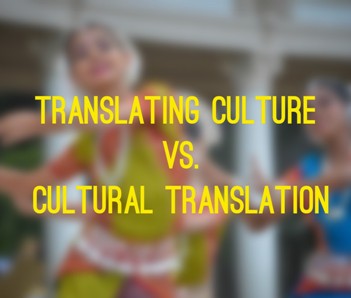By Ravi Kumar
 Harish Trivedi, Professor at the University of Delhi, highly appreciates the fact that over last two or three decades, translation and translation studies have become more visible, more prolific and more respectable activity than ever before.
Harish Trivedi, Professor at the University of Delhi, highly appreciates the fact that over last two or three decades, translation and translation studies have become more visible, more prolific and more respectable activity than ever before.
Trivedi further links this discipline with post-colonial studies that emerged as an area of studies just a few years before translation studies and both have them have become interactive to each through a series of books in this direction, eg. Siting Translation: History, Poststructuralism and the Colonial Context (1992) by Tejaswini Niranjana, The Poetics of Imperialism: Translation and Colonization from The Tempest to Tarzan (1997) by Eric Cheyfitz, Translation and Empire: Postcolonial Theories Explained (1997) by Douglas Robinson, and Postcolonial Translation: Theory and Practice (1999), a collection of essays edited by Susan Bassnett and Harish Trivedi etc.
Before new development took place, translation remained confined to two different subjects or discipline: linguistics and comparative literature, and remained restricted to the substitution of a text in one language for a text in another. But shortly after, it began to be noticed that literary texts were constituted not primarily of language but in fact of culture, language being in effect a vehicle of culture.
Trivedi recognizes that interaction of language with culture helped translation studies expand its horizons and revitalize the discipline. This helped liberate it from the completely mechanical tool of analysis available in linguistics. The words which proved intractable are often described as being culture specific. For example, words like kurta, dhoti, roti, loochi, dharma, karma, or maya etc. began to be treated as specific cultural elements very different from their corresponding western near equivalence shirt, trouser, bread, religion, deeds both past and present, or illusion respectively. Slowly not only some words were taken as culture-specific but indeed the whole language became specific to the particular culture it belonged to.
Trivedi refers to Susan Bassnett and Andre Lefevere who added a cultural dimension to translation studies through their title, ‘the cultural turn in translation studies’ in their book – Translation History and Culture (1990). Trivedi further explains it was Susan Bassnett who declared the death of comparative literature in wake of gaining popularity of postcolonial literature.
Trivedi is concerned with the fact that in parallel there has been the growth of Culture Studies – from Eurocentric beginning to International stature- which is like translation studies is interdisciplinary in nature, but of them have failed to interact properly. Susan Bassnett did propose a four-point agenda: the way in which different culture construct their images of writers and texts, a tracking of the ways in which text become cultural capital across cultural boundaries, and an exploration of the politics of translation, especially of what Lawerence Venuti has called, “ethnocentric violence of translation”, and pooling of the resources.
Trivedi is disappointed with the fact that the cultural turn in translation and culture studies have not come to terms together, maybe because of the fact that translation deals at least between two languages whereas culture studies deal only in one language mainly English. Hence it remains an unfulfilled desire.
Trivedi further moves on to yet another discipline called, “Cultural Translation”. This may not be confused with an old-fashioned sense of translation that involves domestication of text from source to target language. This sort of cultural translation is yet to find its entry in the encyclopedia and anthologies of translation studies, and that this sort of Cultural translation is a dangerous trend that promotes monolingualism, monoculturalism and wants to convert multicultural and diversified world to a monolithic world.
Trivedi sites some examples of this postcolonial and postmodernist discourse and refers to Homi Bhabha who promotes this trend. Trivedi is critical of Bhabha who in his book, “The Location of Culture (1994)” discusses Salman Rushdie’s novel “Satanic Verses” as an example of cultural translation, in spite of the fact that this mentioned book is written originally in English and read in that language only ( not in any other translation). Trivedi calls it a representation of postcolonial diaspora, and what Bhaba is talking about is “Transnational as Translational”. Trivedi rejects this concept and suggests for use of another word in place of translation. It is not a translation, it is a process of human migrancy.
Trivedi further sites examples of Hanif Kureishi, a writer born in England with one British and one Indian/Pakistani parents. He has nothing to do with immigrant population as he is by birth British, but he writes on new British immigrant’s communities because he is being paid for it. Thus Trivedi rejects Bhabha claim that cultural translation is the need of immigrant population, and asserts that such works are hegemonic western demand and necessity.
Trivedi further sites examples of Jhumpa Lahiri, who was born of Bengali parents in London, grew in America to become an American citizen at age of 18. She has written fiction not about Indians in America, but also some stories about Indians still living in India. She has been criticized for having reflected an erroneous and defective understanding of India. She admits that her knowledge of India is limited- the same way- all translations are defective, thus her representation of India is her translation of India. She further elaborates that almost all her characters are translators, insofar as they must make sense to the foreign to survive.
Trivedi is very much worried about the use of the word translation with cultural translation as it dilutes the discipline of translation studies. Therefore, he calls for use of other words like migrancy, exile or diaspora with culture to describe such phenomenon, but not the “Translation”.
Trivedi is worried over Susan Bassnett’s statement on Edwin Gentzler’s book, “Contemporary Translation Theories” where she says, “… the book is not only a critical survey but effectively also a translation, it transforms a whole range of complex theoretical material into accessible language”. Trivedi puts his concern by saying, “it is the same language as English, in which such theoretical complexity and such accessibility both exist”.
Thus we notice that Trivedi ‘s concern on dilution of the word ‘translation’ with the monolingual cultural interpretation of migrant population is quite genuine and that a careful approach is needed to tackle such dilution process that aims to bury multilingualism, multiculturalism and diversity of culture in name of cultural translation.





